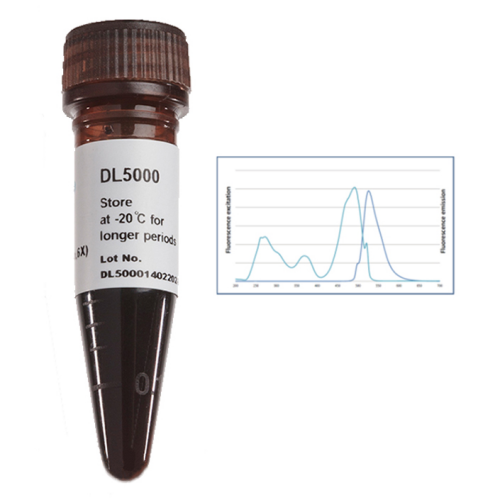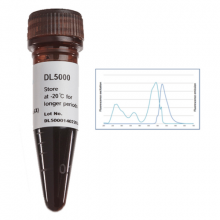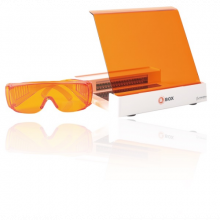
FluoroDye™ DNA Fluorescent Loading Dye



FluoroDye™ DNA Fluorescent Loading Dye is a ready-to-use 6x DNA loading dye designed for fast, qualitative electrophoresis analysis. FluoroDye™ Fluorescent DNA Loading Dye contains sensitive fluorescent dye with high specific affinity towards double stranded DNA (dsDNA). It has negligible background, rendering the destaining process unnecessary.
With FluoroDye™ DNA Fluorescent Loading Dye, the user can immediately visualize electrophoresis results upon completion and can monitor electrophoresis in real time. FluoroDye™ DNA Fluorescent Loading Dye is compatible with both the conventional UV gel-illuminating system and the less harmful, long wavelength blue light illumination system, including the B-BOX Blue Light LED epi-illuminator. The emission of FluoroDye™ when bound to dsDNA is 522 nm, while the excitation peaks occur at 270, 370 and 497 nm.
- Excellent for post staining
- Safe alternative to EtBr
- Sensitivity of 0.04 ng DNA
- Negligible background; does not require destaining process
- Compatible with both UV and blue light
- Increased cloning efficiency (blue light)
- Electrophoresis analysis and monitoring
- DL5000 - FluoroDye™ DNA Fluorescent Loading Dye (Green, 6x), 1ml
- DL5001 - FluoroDye™ DNA Fluorescent Loading Dye (Green, 6x), 5ml
1. Will FluoroDye™ DNA Fluorescent Loading Dye affect the DNA samples in subsequent experiments?
Using FluoroDye™ DNA Fluorescent Loading Dye does not affect subsequent operations. The fluorescent dye can easily be removed by regular alcohol precipitation or gel elution kits.
2. Will FluoroDye™ affect cloning efficiency?
Using the fluorescent dye coupled with blue light, the cloning efficiency is increased by about 100 times compared to using EtBr and UV light.
3. How can the FluoroDye™ be removed from DNA?
The dye can be removed from DNA with traditional ethanol precipitation, PCR clean up kits, or gel extraction kits. The ethanol precipitation method can follow conventional molecular cloning or follow the listed protocol.
Ethanol Precipitation:
- Measure the volume of the DNA sample.
- Add 1/10 volume of 3M sodium acetate, pH 5.2 (final concentration of 0.3 M) - The pH value of 3M sodium acetate must be adjusted with acetate, not with HCl.
- Mix well.
- Add 2 to 2.5 volumes of cold 100% ethanol (calculated after salt addition).
- Mix well.
- Place on ice or at -20°C for >20 minutes.
- Spin at maximum speed in a microfuge for 10-15 min.
- Carefully decant supernatant.
- Add 1 mL 70% ethanol. Rinse and spin briefly. Carefully decant supernatant.
- Air dry or briefly vacuum dry pellet.
- Re-suspend pellet in the appropriate volume of TE, Tris buffer or water.
4. Can DNA stained with FluoroDye™ be used for enzymatic reactions? Do you have any recommended methods, such as pretreatment?
After removing the fluorescent staining dye from DNA, the DNA can be used for ligation, restriction enzyme digestion or PCR reactions. It is imperative that the DNA is maintained in good quality for bioassays after removing the stained dye. It is recommended to remove the fluorescent staining dye with gel extraction kits or PCR clean up kits because these methods are convenient and highly efficient. The low amount of fluorescent staining dye does not affect ligation, enzyme digestion or PCR. However, the threshold is related to the enzyme systems and it is on a case-by-case basis. For the best results, remove the fluorescent staining dye from DNA before proceeding to the next step of the experiment.
5. As FluoroDye™ is used, is the migration of DNA affected by the fluorescent dye?
Yes, it might be affected due to variation of the amount of DNA mixed with the fluorescent loading dye. The fluorescence composition in a fluorescent loading dye is fixed, so for different amounts of DNA, different degrees of binding to fluorescent dyes are expected. Variety in DNA/fluorescence ratios might lead to variation in DNA migration; the higher the fluorescence ratio, the slower the DNA fragments migrate. In general, a DNA amount of ≥31.25 ng with 1 μl loading dye will be an acceptable range. If the DNA concentration is lower than 31.25 ng, the molecular weight determination may be slightly distorted. For analyzing DNA samples of unknown concentration, it is recommended to use this dye with post-staining methods or to use FluoroVue™ nucleic acid staining dye with the in-gel staining method.
Boca Scientific is your premiere source for high-quality, innovative solutions for Cell Biology, Molecular Biology, Immunology, genetics and other lab products and reagents. We bring leading-edge products from our own-line and around the world to laboratories in the US and Canada. Our goal is to offer excellent solutions to drive research and discoveries backed by superior customer support.

 B-BOX Blue Light LED Epi-Illuminator
B-BOX Blue Light LED Epi-Illuminator